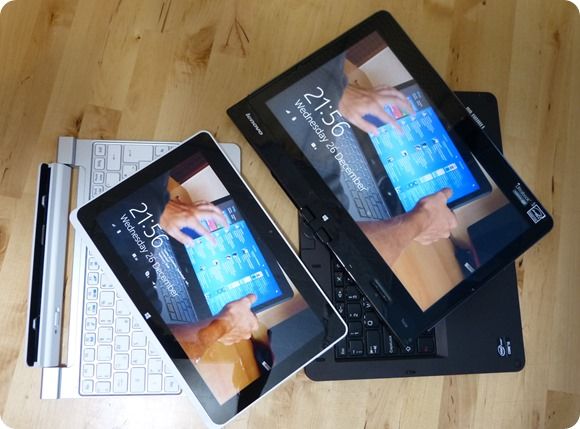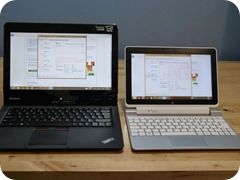
For some people it’s more important to be mobile with all-day, all-scenario capability at the expense of processing power or speed. For others, the most important thing is to be able to carry desktop power. Intel Atom and Intel Core separate these two areas of computing cleanly but how big is the difference in platform performance? I took the chance to test the Acer W510 alongside an Ultrabook convertible the Lenovo Thinkpad Twist. Both devices have strengths, and weaknesses.
A copy of this article also appears on our sister site, Ultrabooknews.
Before you check out the video there are a few things to note. Firstly, I’m not testing form factors, mobility or battery life here
Secondly. it’s important that customers always find a device that fits 100% or more of their needs. Having a device that “does 90% of what I need inch is a device that fails on 10% of the tasks you want to do on it.
This video presentation is an attempt to see what happens when you put a hybrid hard-drive Core-based device up against an SSD-Atom based device in terms of application usage. I haven’t compared a large sample of CloverTrail and Ultrabook devices here but the application test results are quite representative of what you’ll find across the board in my opinion. I haven’t done much in terms of GPU-intensive comparisons.
- Boot up speed comparison. (See this section on the video)
- Application start-up times. (See this section)
- YouTube performance comparison (and the effects of Wi-Fi performance) (See this section)
- Discussion and demo on the importance of a strong Wi-Fi subsystem. (See this section)
- Sunspider performance. (See this section)
- Intel Quick-Sync video editing comparison. (See this section)
- CPU-based video rendering comparison. (See this section)
- 720p playback CPU load test. (See this section)
- Windows 8 application start-up (where the devices are very evenly matched) (See this section)
- Unzip operation (Where the Core-based system provides a huge, huge real-world advantage) (See this section)
- Microsoft Office usage (see this section on video)
You won’t be surprised that the Core-based system wins most of these tests but there are some areas where the differential is quite small. Many Windows 8 applications, for example, don’t get much benefit from having Core over Atom due to their ‘quick-snack’ nature.
I haven’t mentioned ‘Connected Standby’ either which is a massive difference in the way these PC platforms work. The CloverTrail devices can’t hibernate or standby at all, they just turn the screen off and go into a quiet mode where Windows 8 apps are poling, audio apps can stream and Wi-Fi is still on. It results in many days of background tasking which means applications like Skype, email and Twitter can continue to update and notify. Clovertrail devices are ready as soon as you press the ‘power’ button. Core-based devices, on the other hand, require waking from a sleep state where nothing functions in the background. A 5-second reconnect is then followed by a rush of activity from applications to get their internet updates.
Clovertrail devices are smaller and lighter too so combined with the always-on feature, are more suited to on-the-road activities. With the W510 you’ve even got a lightweight tablet that’s detachable.
We could talk about the lack of USB3.0 or SATA, GPU and security features but for this article, let’s get back to applications performance so you can see just how big the differences are. The video is long, but worth a watch if you’re interested in the difference between current Atom and Core-based systems.Click on the links above to hop direct to a specific section of the video.












Thanks for this comparison. Great job as always.
Hope you had nice holidays, too.
One question out of curiosity, when logging in does the W510 accept password input from the keyboard dock or only from the OSK?
it’ll accept input from any connected input device
I haven’t dipped into the video yet, but it’s interesting this appears a day after what LAPTOP mag declared:
Don’t Believe the Hybrid Hype: $750 Windows 8 Netbooks Not Worth It
http://blog.laptopmag.com/don%E2%80%99t-believe-the-hybrid-hype-750-windows-8-netbooks-not-worth-it
On paper, the atom really looks like a poor contender. but it’s surprising that as a media tablet it works fantastically! and as long as you remember that you’re running on a netbook and not push it like an ultrabook, you’ll be ok.
Having seen the Core chip pop up things just about instantly versus the Atom… I’d really like that performance. Even so, the Atom in the video is still *faster* than the damn Celeron in my desktop.
The laptopmag blog cherry picks and is not very convincing:
1) The W510 can be had for only $399 shipped to most states without paying any taxes–so that Atom tablet is not some $750+ as the author tries to stress.
2) The W510 is lighter than iPAD; the app count is low but then tell me when iPad’s browser can run Java, Flash, custom ActiveX controls in the browsers. Now, Windows RT is crippled, I’d concede that.
3) Again, let’s consider W510’s four different form factors. Is there ANY device out there which has these form factors and yet provides a very light 10″ tablet?
4) W510 can’t be my main computer; the horse power is not there; the screen res is too low. But I don’t foresee myself crunching 20,000 Excel sheet calculations on this device. If I need to do serious work then I can go to my workstation and get it done there or Remote Desktop to it without installing any ‘apps’.
5) The author thinks that W510’s battery life is lower than iPad’s. Yes, only slightly lower in the tablet mode but then W510 has 10″ screen too. Also, the so-called high price of W510 is because of the keyboard dock which doubles the battery life to much more than iPad’s battery life. This should have been pointed out by the author in a post which is complaining about the high price of Atom based tablets.
and just to add to tzhis list, the W510 runs a full os (compared to ipad or andrioi devices) and full blown legacy applications of any sort, meaning its a lightweight, portable tablet platform running more or less the same stuff like at home or at work on a desktop. btw wait a half year or so and prices wil start dropping as always.
The Acer W510 is basically a tablet netbook, the Modern UI side will run pretty well and will actually show little difference in higher powered systems but the desktop will only run about as well as traditional netbooks.
So have to avoid resource intensive apps like gaming and more powerful programs that usually require pretty powerful systems to run properly.
However, Office and other more basic programs will run fine and any slow downs should be limited to multi-tasking most of the time.
Average specs are slightly better than most previous netbooks though, but the driver support for the GMA needs to improve.
Hopefully, with the Clover Trail+ release they’ll start providing 64bit support as the ATOM can support it and models like the previous Cedar Trail N2800 indicates they could possibly up the RAM support to 4GB, but for now they’re limited to 32bit and only 2GB of RAM.
The lack of anything but generic drivers for OS other than W7/W8 is also a point of annoyance and prevents the same range of flexibility as traditional netbooks.
According this: http://liliputing.com/2012/12/intels-clover-trail-tested-it-beats-most-arm-based-chips-most-of-the-time.html
Clover Trail outperforms ARM chips.
Yes, benchmarks seem to show that this is true for most present gen, and older, ARM SoCs until the next gen models, like the Cortex A15 based Exynos 5 series, are starting to show some decent performance that rivals the ATOM with dual cores and with quad cores can pull clearly ahead.
Though graphically, the opposite is presently true with Tegra 3 on up having better overall graphical performance… At least until the Clover Trail+ comes out and replaces the SGX545 based GMA with one based on the better performing SGX544, most likely in dual configuration for a more significant jump in performance.
However, by then we’ll probably see Tegra 4 and other next gen ARM SoC’s come out.. Though, on the other hand, those updates will be about it for the next year or so and the next gen 22nm ATOM update will start coming out in the second half of 2013, which should probably provide enough of a performance boost to put Intel on top again, but timing will be tight and some won’t come out until early 2014 (like the Medfield replacement, Merrifield).
It’ll at least be a race then as Intel plans to release updates for the ATOM every year from then on…
Mind, though, that for desktop performance Clover Trail is still a netbook range product… though, at least we’re finally past the 1024×600 resolution that most netbooks had been stuck with… we just have to wait for the prices to go back down and see if they can provide better driver support…
However, the 22nm update will allow for up to quad cores, improved CPU architecture, support for up to 8GB of RAM, Ivy Bridge HD4000 based GMA (scaled down about 1/4), and other improvements. So we might get closer to CULV level performance with next gen devices.